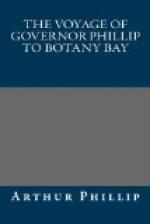Psittaceous hornbill. Order ii. Pies. Genus VIII.
The bird is about the size of a crow: the total length two feet three inches: the bill is large, stout at the base, much curved at the point, and channelled on the sides; the colour pale brown, inclining to yellow near the end: the nostrils are quite at the base, and are surrounded with a red skin, as is the eye also, on the upper part: the head, neck, and under parts of the body are pale blue-grey; the upper parts of the body, wings, and tail, ash colour; and most of the feathers are tipt with dusky black, forming bars of that colour across the wings: the wings, when closed, reach to near three-quarters of the length of the tail: the tail itself is long, and cuneiform, the two middle feathers measuring eleven inches, and the outer one on each side little more than seven; a bar of black crosses the whole near the end, and the tips of all the feathers are white: the legs are short and scaly, and the toes placed two forwards, and two backwards, as in those of the toucan or parrot genus: the colour of legs and claws black.*
[* Mr. Latham, who has been kind enough to give his sentiments on this occasion, is of opinion that this bird does not strictly belong to any of the present established genera. The make indeed is altogether that of an hornbill, and the edges of the mandible are smooth, but the toes being placed two forwards and two backwards, seem to rank it with the Parrots or Toucans; and it has been unlucky that in the specimen from which the description was taken, the tongue was wanting, which might in a great measure have determined the point: but the inducement for placing it with the hornbills has had the greater weight, as not a single species of the toucan tribe has yet been met with in that part of the world.]
This bird was killed at Port Jackson, and we believe it to be hitherto non-descript.
* * * * *
Such is the account of the birds of which drawings or specimens have been obtained from Port Jackson or from Norfolk Island. Wild ducks, teal, quails, and other common species are numerous in both places, and the variety, as well as number of the small birds is considerable. Birds of the Cassowary or Emu kind have very frequently been seen; but they are so shy, and run so swiftly, that only one has yet been killed. That bird was shot near the camp, while Governor Phillip was absent on his first expedition to Broken Bay, and was thought by him to differ materially both from the ostrich and cassowary; the skin was sent over, but at the time when this sheet was printed off, had not been stuffed, or put into form. Should it, on examination, exhibit any remarkable peculiarities, we shall endeavour to obtain a description of it, to subjoin at the conclusion of this volume.
* * * * *
Since stating the dimensions of the kanguroo, in page 106, Lord Sydney has received from Governor Phillip, a male of a much larger size, which measures as follows.




